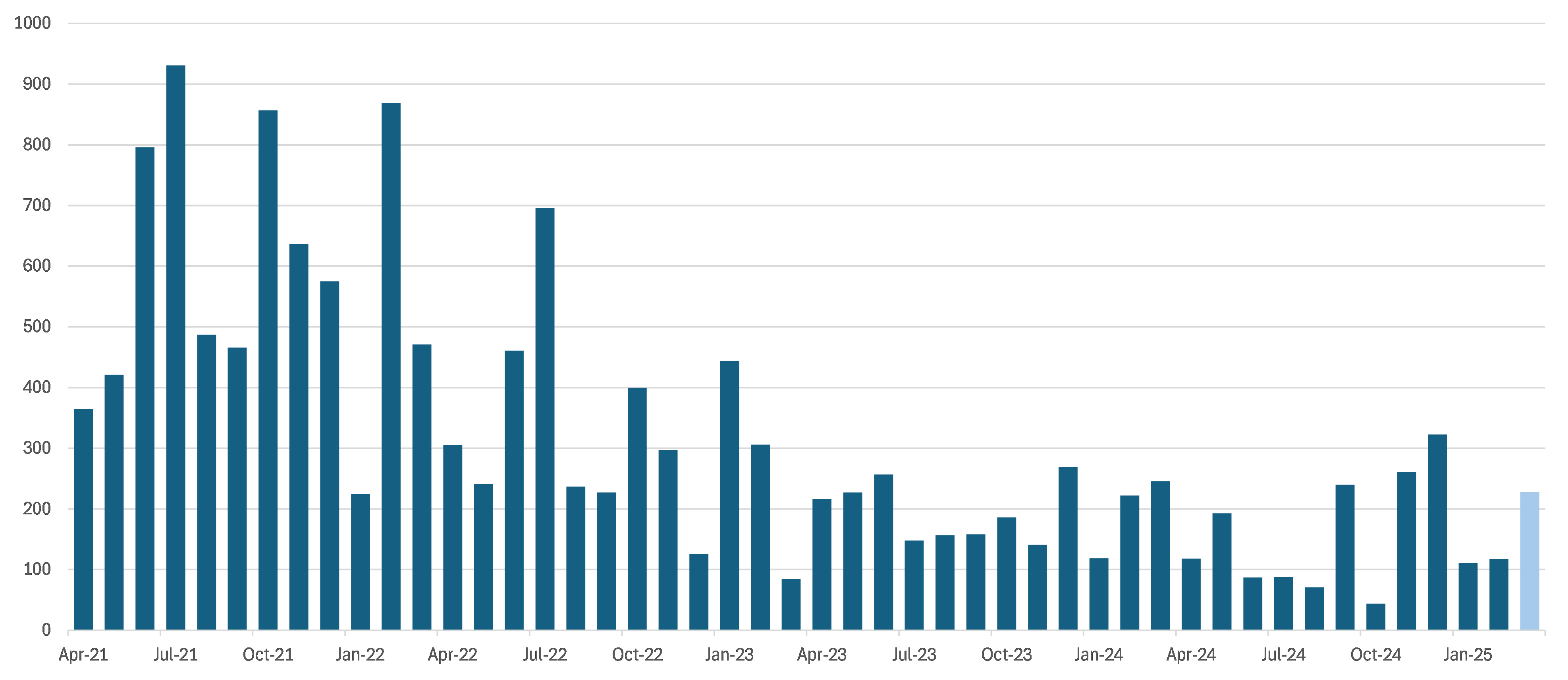Summary
- Canadian dollar weakens this morning after strengthening yesterday to the best levels since December 6, 2024.
- Euro currency climbs to strongest level since October 1, 2024.
- Market turmoil deepens as China sets 34% tariffs on U.S.
- U.S. March nonfarm payrolls rise 228,000 month/month exceeding consensus estimate of +140,000.
- U.S. unemployment rate 4.2%; estimate 4.1%.
- Treasuries breech 4% as U.S. 10-year yields fall to 3.92%. Treasury 30-year bond yield falls to lowest level since December.
- Australian dollar extends drop to 1.5%, most in two months on risk aversion.
- Morgan Stanley boosts bullish Japanese yen target on U.S. recession fears. Japan 10-year yield falls thirteen basis points amid haven demand.
- Norway will not retaliate against U.S. tariffs, trade minister says.
- China tariff retaliation hits crop prices.
- Oil prices slide to lowest since 2021.
Noteworthy
- U.S. Dollar Touches 6-Month Lows Yesterday on Tariff Fallout
- Hiring Defied Expectations in March, With 228,000 New Jobs
The euro currency turned lower against the dollar after the U.S. data showed non-farm payrolls rose much more than expected in March. The news provides some—albeit limited—relief that the U.S. jobs market was healthy ahead of an expected substantial hit to the economy after President Trump’s sweeping trade tariffs.
“Economic weakness is coming, but at least we can be reassured that the labor market was robust coming into this policy-driven shock,” Principal Asset Management said in a note.
However, employers added jobs in March at a much stronger pace than expected a sign that the labor market remained strong despite economic uncertainty, government layoffs and market turbulence.
The U.S. added 228,000 jobs in March, versus 140,000 additional jobs forecast. The euro fell 0.3% to $1.1016, from $1.1088 before the data. It hit a six-month high of $1.1148 Thursday.
That was also well above the average monthly gain of 158,000 over the prior 12 months. However, job gains for January and February were revised lower. The U.S. added 117,000 jobs in February.
Services-sector hiring picked up in March after a period of winter weakness in industries like leisure and hospitality. Healthcare added 54,000 jobs, including jobs at hospitals and nursing facilities. The transportation sector also had strong growth, adding jobs for couriers and messengers and in truck transportation.
Economists said that while the strong report offers some relief about the recent state of the U.S. labor market last month, that is likely to be upended by the new tariff uncertainty.
“The primary takeaway for the March jobs report is that it represents the calm before the storm,” said Joseph Brusuelas, chief economist at RSM, adding “the new tariff regime is going to damp hiring and send unemployment higher in the coming months.”
US Non-Farm Payrolls

The report failed to halt the continued market selloff Friday. Stocks kept falling sharply after the market opened, after already plunging steeply on Thursday. The Trump administration announced sweeping new tariffs on countries around the world late Wednesday.
The unemployment rate, which is based on a separate survey from the jobs figures, ticked up to 4.2% as more people entered the labor force.
The Department of Government Efficiency’s federal-government layoffs were a modest drag on payrolls. Federal government employment declined by just 4,000 in March, after dropping 11,000 in February.
The Trump administration’s efforts to lay off thousands of federal workers have been held back by lawsuits and court orders that put workers on paid administrative leave, or back on the job. Employees who were on paid leave or receiving ongoing severance were counted as employed.
American households and businesses are becoming more jittery about the economy’s future due to uncertainty about trade policy and rising costs, according to recent surveys.
The report has marginal impact on the U.S. dollar and the bulk of this week’s downward movement happened Thursday. The U.S. dollar extended its fall yesterday, dropping to a six-month low against the safe-haven currencies Japanese yen and Swiss Franc, after China announced counter-tariffs in the wake of U.S. President Trump’s widespread tariff announcements late Wednesday.
China said it would impose a 34% tariff on all imported goods from the U.S., with effect from April 10. The news gives weight to fears of an escalating trade war, alongside concerns about a big hit to the U.S. and global economies. The dollar fell 0.7% to a low of 145.04 yen and dropped more than 1% to 0.8504 Swiss francs, data show.
Contact Comerica Foreign Exchange
This is not a complete analysis of every material fact regarding any company, industry or security. The information and materials herein have been obtained from sources we consider to be reliable, but Comerica Capital Markets does not warrant, or guarantee, its completeness or accuracy. Materials prepared by Comerica Capital Markets personnel are based on public information. Facts and views presented in this material have not been reviewed by, and may not reflect information known to, professionals in other business areas of Comerica Capital Markets, including investment banking personnel.
The views expressed are those of the author at the time of writing and are subject to change without notice. We do not assume any liability for losses that may result from the reliance by any person upon any such information or opinions. This material has been distributed for general educational/informational purposes only and should not be considered as investment advice or a recommendation for any particular security, strategy or investment product, or as personalized investment advice.


